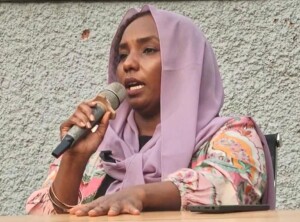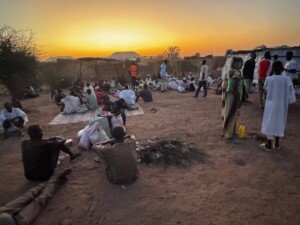Acute watery diarrhoea, dengue fever reported after rains in Sudan’s Blue Nile, Red Sea states
Six cases of acute watery diarrhoea – which is often caused by cholera* – have been admitted to Ed Damazin Hospital in Sudan’s Blue Nile State this week. The rains have also seen an increase in cases suspected to be the mosquito-borne haemorrhagic (severe dengue) fever admitted to Port Sudan hospital.
 Cholera patients in Salemeen village in El Gedaref in 2017 (File photo: RD)
Cholera patients in Salemeen village in El Gedaref in 2017 (File photo: RD)
Six cases of acute watery diarrhoea – which is often caused by cholera* – have been admitted to Ed Damazin Hospital in Sudan’s Blue Nile State this week. The rains have also seen an increase in cases suspected to be the mosquito-borne haemorrhagic (severe dengue) fever admitted to Port Sudan hospital.
Sources told Radio Dabanga that the isolation ward of the hospital received four cases of watery diarrhoea from Syrio, north of the Blue Nile state capital and two other cases from Ed Damazin town itself.
They pointed out that the cases have emerged after this week’s rainfall and that there has been a move by Ed Damazin health authorities to combat the disease.
Minister of Health
Last month, Sudan’s federal Minister of Health, Bahr Idris Abu Garda told a coordination meeting of ministers of the states in Sennar, that Sudan is now free of the 'watery diarrhoea' outbreak (suspected to be cholera) that hit various parts of the country during the past year.
Minister Abu Garda called for the necessary precautions to raise awareness, hygiene, and chlorination of drinking water to prevent a renewed outbreak of the disease.
His statement contradicts an earlier announcement by the World Health Organization (WHO) which said that there are still patients with the disease being treated in Central Darfur. “The total number of new acute watery diarrhoea cases reported from Central Darfur from February to March is 468, with almost all cases reported from 63 inaccessible villages in western Jebel Marra.”
Suspected cholera
In spite of numerous independent confirmations (conducted according to WHO standards) that the disease which broke out in Blue Nile state in August 2016 was cholera, the Sudanese authorities and several international organisations persistently refer to it as ‘acute watery diarrhoea’.
The WHO and the Sudanese Ministry of Health reported in mid-October that the total number of recorded cases reached more than 35,000 people – including 800 related deaths. Doctors of Sudan’s National Epidemiological Corporation reported in early July however, that nearly 24,000 Sudanese had been infected and 940 cholera patients died.
Haemorrhagic (severe dengue) fever
Voluntary work activists in Port Sudan reported outbreaks of unknown fevers, believed to be haemorrhagic (severe dengue) fever**, in a wide area of the city two weeks ago.
Activists told Radio Dabanga that the Port Sudan Hospital wards have been full of people with fever, where a large number of the infected would prefer to receive treatment in their homes.
They said no deaths have been recorded due to the fevers and warned of the worsening situation in the event the health authorities in the state do not take measures to contain the disease.
According to the WHO, in 2017, the Sudanese Ministry of Health reported an increase in the number of suspected dengue fever cases during the period between 2 October and 8 December.
The UN Office for the Coordination of Humanitarian Affairs (OCHA) reported in its biweekly humanitarian bulletin that a total of 137 suspected cases, including three deaths, were reported from Khartoum, East and West Darfur, South Kordofan, River Nile and El Gezira states, Kassala and Red Sea states in this period.
*Cholera key facts (Source: WHO)
- Cholera is an acute diarrhoeal disease that can kill within hours if left untreated.
- Researchers have estimated that each year there are 1.3 million to 4.0 million cases of cholera, and 21 000 to 143 000 deaths worldwide due to cholera.
- Most of those infected will have no or mild symptoms, and can be successfully treated with oral rehydration solution.
- Severe cases will need rapid treatment with intravenous fluids and antibiotics.
- Provision of safe water and sanitation is critical to control the transmission of cholera and other waterborne diseases.
- Safe oral cholera vaccines should be used in conjunction with improvements in water and sanitation to control cholera outbreaks and for prevention in areas known to be high risk for cholera.
- A global strategy on cholera control with a target to reduce cholera deaths by 90 per cent was launched in 2017.
**Haemorrhagic (severe dengue) fever key facts (Source: WHO)
- Dengue is a mosquito-borne viral infection.
- The infection causes flu-like illness, and occasionally develops into a potentially lethal complication called severe dengue.
- The global incidence of dengue has grown dramatically in recent decades. About half of the world's population is now at risk.
- Dengue is found in tropical and sub-tropical climates worldwide, mostly in urban and semi-urban areas.
- Severe dengue is a leading cause of serious illness and death among children in some Asian and Latin American countries.
- There is no specific treatment for dengue/ severe dengue, but early detection and access to proper medical care lowers fatality rates below 1 per cent.
- Dengue prevention and control depends on effective vector control measures.
- A dengue vaccine has been licensed by several National Regulatory Authorities for use in people 9-45 years of age living in endemic settings.
Follow #CholeraInSudan, #الكوليرا_السودان for ongoing coverage by Radio Dabanga











 and then
and then